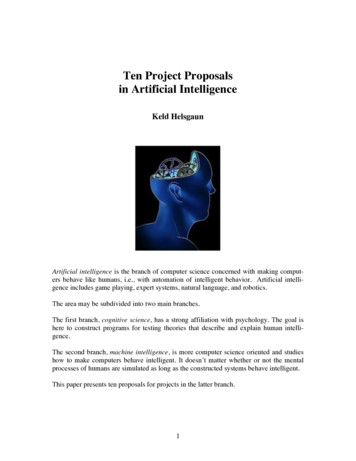Physics 330 Decoherence In QM
Physics 330Decoherence in QMM. Goldupdated Feb. 2020diffraction experimentslits1 or 2slits1 and 2‘‘In reality, it contains the only mystery, the basic peculiarities of all ofquantum mechanics.’’ R. P. Feynman and A. R. Hibbs, QuantumMechanics and Path Integrals McGraw-Hill, New York, 1965.
Heisenberg’s Microscopexfrom Feynman Vol IIIΔxwhich slit determination destroys interferenceΔpx h/ΔxFeynman emphasizes that decoherence occurs whether or not youdetect the scattered photons
Quantum interference experiments with large moleculesOlaf Nairz,a) Markus Arndt, and Anton Zeilingerb)Institut für Experimentalphysik, Universität Wien, Boltzmanngasse 5, A-1090 Wien, Austria!Received 27 June 2002; accepted 30 October 2002"Am. J. Phys., Vol. 71, No. 4, April 2003 Nairz, Arndt, and Zeilinger#Wave–particle duality is frequently the first topic students encounter in elementary quantumphysics. Although this phenomenon has been demonstrated with photons, electrons, neutrons, andatoms, the dual quantum character of the famous double-slit experiment can be best explained withthe largest and most classical objects, which are currently the fullerene molecules. Thesoccer-ball-shaped carbon cages C60 are large, massive, and appealing objects for which it is clearthat they must behave like particles under ordinary circumstances. We present the results of amultislit diffraction experiment with such objects to demonstrate their wave nature. The experimentserves as the basis for a discussion of several quantum concepts such as coherence, randomnesscomplementarity, and wave–particle duality. In particular, the effect of longitudinal !spectral"coherence can be demonstrated by a direct comparison of interferograms obtained with a thermalbeam and a velocity selected beam in close analogy to the usual two-slit experiments using light. 2003 American Association of Physics Teachers.Fig.10.1119/1.1531580 2. The fullerene molecule C60 , consisting of 60 carbon atoms arranged#DOI:in a truncated icosahedral shape, is the smallest known natural soccer ball.Fig. 4. Textbook appromaxima of a monochroof the woI. INTRODUCTIONsee earlierinwork,PRLVOLUME88,NUMBER10MARCH112002the United States by the architect Buckminster whichthey hThis new modification of pure carbon was discovered ysRevLett 88 100404.pdfwavelength.ordand constant phase relation,andHighermay ther32At the beginningofthe20thcenturyseveralimportant1985 by Kroto et al. and shown to be particularlystabletudinalcoherenceatas being coherent withrespectto eachin othdiscoveries were made leading to a set of mind-bogglingincreases the longitudinand abundant when exactly 60 carbon atoms areForarrangedin picturewatertheappears intuitive bquestions and experiments that seemed to escape any anthereforepermits the obone molecule to form the smallest natural soccer ball we#
900 Kers requiresor. For theor that surncy, spatialon laser, allbeam widthis orthogoss the laseran internalhe positivectrode at 10. The elece pulses areection effimagnitudement ionizathat amongctor is onlyscheme andhe tight for detector35Fig. 5. Velocity distribution of the C60 molecules for a thermal and a velocity selected beam. The thermal beam !gray curve" is centered around v̄!200 m/s and has a width of & v / v 0.6, while the selected beam !blackcurve" is centered around v̄ !117 m/s with a width of & v / v 0.17. Wetherefore expect the velocity selected interference pattern to be expanded by70% on the screen and to show at least three times (!0.6/0.17) as manyinterference orders as the unselected pattern.
le statesbrationalNow theyusediffractivea 100nmelementgratingB.TheinternaldicatorsBecause the de Broglie wavelength is about five orders ofAnd wemagnitude smaller than any realistic free-standing mechanild spoilcal structure, we expect the characteristic size of the interferotion.ence phenomena to be small. A sophisticated machinery isperimenttherefore necessary to actually show them. As the diffractingstandardg of 60 carbon atoms arrangedelementwe used a free-standing silicon nitride grating with aestknownnaturalsoccerball.counterFig. 4. gratingTextbook approachto double-slit diffraction.First-order einterferencesource,of the waveletsthat emergefrom two neighboringslits. The 200corresponding31!55 5nmandthicknessofonlynm along the beamctBuckminsterFuller.path length difference between the two paths is equal to the de Brogliector.bon was discovered inwavelength.Higher orderinterference willarebe spoiledbythe limitedlongi- edge of currenttrajectory.Thesegratingsatthecuttingo be particularly stabletudinal coherence in a thermal source. Velocity selection in our experimentsincreases theandlongitudinalcoherencelengthspecialistsby more than a factorof 3 andn atoms are arrangedintechnologyonlyafewworldwidecan rinterferencefringes.natural soccer ball we34makethem.g. 2.es because a successfulAs theWediffractingelementwe used ectionangletothefirstdifld bepowregarded as an imnegratingwithaordernominalconstantof dfor approximation100slit openingswhereh is Planck’sconstant.Accordingly,a C60 nm,fullerenefractioningratingthesmallangleas the ratioour macroscopic world:#24ofof s are 55 5andofthicknessof only200a nmalongbeamwithnma massm!1.2"10kg andvelocityof vthe!200ertiesaboutof /s, we find a wavelength of "!2.8 pm.ot solidmaterialtrajectory.than toectmolen used in matter wavea smalltivemany-particle states#122.8"10m"h variety of vibrationalvelocitydiffractive elemente concept of an internal % B.!28!The !&rad.#2 #7e of the clearindicatorsd the de10preadofBecauseBrogliemwavelength is about five orders ofthe fullerenes. And wemagnitude smaller than any realistic free-standing mechanicomplexity could spoilributioncal structure, we expect the characteristic size of the interferenter of mass motion.In elementarytextbooks#2 is usuallyderived using Fig.ence phenomenato be small. Eq.A sophisticatedmachinery is
v mp of about 200 m/s and a nearly thermal velocity spread of! v / v mp!60%. Here ! v is the full width of the distributionat half height.To calculate the expected diffraction angles, we first needto know the de Broglie wavelength which is uniquely determined by the momentum of the moleculeh,"!mv321U.Vienna experiment#1 schematicAm. J. Phys., Vol. 71, No. 4, April 2003dIn elementary t4 and noting thwhen the differto one de Broglat 1.2 m downtween the interfonly L" % !1.2
of flight distribution we chopped the fullerene beam with thewe also have to takein the zeroth order w!holes" of the gratinggrating period.III. CONCLUDINGA. Single particle inFig. 7. Far-field diffraction of C60 using the slotted disk velocity selector.The mean velocity was v̄ !117 m/s, and the width was # v / v 17%. Fullcircles represent the experimental data. The full line is a numerical modelbased on Kirchhoff–Fresnel diffraction theory. The van der Waals interaction between the molecule and the grating wall is taken into account in formof a reduced slit width. Grating defects !holes" additionally contribute to thezeroth order.323Am. J. Phys., Vol. 71, No. 4, April 2003It is important to nup from single, sepabetween two or morapparatus. Single pacase by two indepenThe first argumentween the moleculesof 200 m/s is 3"1tor. This flux corresp1.7"1011 m#3 or anThis is three ordersrange of molecular !cally confined to sevThe second argumoccurs only betweenmolecules may be re
Decoherence of matter waves by thermal emission of radiationLucia Hackermüller, Klaus Hornberger, Björn Brezger, Anton Zeilinger & MarkusArndtNature 427, 711-714 (19 February 2004)Large molecules are particularly suitable for the investigation of the quantum–classical transition because they can store much energy in numerous internaldegrees of freedom; the internal energy can be converted into thermal radiationand thus induce decoherence. Here we report matter wave interferometerexperiments in which C70 molecules lose their quantum behaviour by thermalemission of radiation. We find good quantitative agreement between ourexperimental observations and microscopic decoherence theory. Decoherence byemission of thermal radiation is a general mechanism that should be relevant to allmacroscopic bodies.
A fullerene beam passes from left to right, interacting with a heating stage, a three-grating (G1–G3) matterwave interferometer and an ionizing detection laser beam in D2 (wavelength 488 nm, 1/e2 intensity radius6.6 m, 15 W). The gold gratings have a period of 991 nm and slit widths of nominally 475 20 nm.Decoherence of the fullerene matter waves can be induced by heating the molecules with multiple laserbeams (514.5 nm, 40 m waist radius, 0–10 W) before they enter the interferometer. The resultingmolecular temperature can be assessed by detecting the heating-dependent fraction of fullerene ions usingthe electron multiplier D1 over the heating stage.
The fringe visibility V decreases with increasing heating power P owing to the rising emission probability of visiblephotons: P 0 W (V 47%), P 3 W (V 29%), P 6 W (V 7%), P 10.5 W (V 0%). In contrast to that, the absolutecount rate grows initially with increasing P. This is due to the fact that the thermal ionization probability in detector D2increases with the temperature of the arriving molecules. At even higher heating intensities the count rate falls againbecause of ionization and fragmentation in the heating stage.
a, Interference visibility as a function of laserheating power (lower scale). The molecularbeam with a mean velocity of vm 190 m s-1passes a 50 m central height delimitercomparable to the waist (40 m) of the 16 heatinglaser beams. We observe a rapid decrease of thefringe visibility with increasing power both inthe experiment (circles) and in theory (solidline). The upper axis indicates the meantemperature of the molecules when they enterthe interferometer. The maximum contrastwithout heating was V0 47%, which is close tothe theoretical value11.b, Molecules with vm 100 m s-1, selected by a150 m height delimiter and heated by ten beamsof the specified incident laser power. Thequalitative behaviour is the same and thequantitative agreement with theory is as good asbefore. The maximum contrast for this velocityclass was V0 19%. In both experimentalarrangements, a mean number between one andtwo visible photons is required to reduce thecontrast by a factor of two.
This experiment proves three things:1) First, it shows that decoherence due to heat radiation can be quantitatively tracedand understood.2) Second, it confirms the view that decoherence is caused by the flow ofinformation into the environment. In matter-wave interferometers, which onlyobserve the centre-of-mass motion alone, information can only be mediated by atransfer of momentum.3) Finally, it shows that thermal decoherence is relevant for truly macroscopicobjects. Fortunately, it will be less of a concern in future interferometry experimentswith large molecules, clusters or nano-crystals. Objects like these will have to besubstantially cooled to make them coherent and to suppress the emission of thermalradiation.
Physics 330 slits 1 or 2 slits 1 and 2. which slit determination destroys interference Δp x h/Δx . Perfect interference con-trast can be obtained only if we open the second slit and if we exclude all possibilities of detecting, even in principle,
BMW 5 E39 VIDEO TUTORIAL This replacement procedure can be used for: BMW 3 (E46) 330 i, BMW 3 (E46) 330 xi, BMW 3 Convertible (E46) 330 Ci, BMW 3 Coupe (E46) 330 Ci, BMW 3 Coupe (E46) 330 xi, BMW 3 Touring (E46) 330 i, BMW 3 Touring (E46) 330 xi, BMW 5 (E39) 530
Physics 20 General College Physics (PHYS 104). Camosun College Physics 20 General Elementary Physics (PHYS 20). Medicine Hat College Physics 20 Physics (ASP 114). NAIT Physics 20 Radiology (Z-HO9 A408). Red River College Physics 20 Physics (PHYS 184). Saskatchewan Polytechnic (SIAST) Physics 20 Physics (PHYS 184). Physics (PHYS 182).
LEXION 780 TT 10 C69 540 / 576 385 LEXION 780 10 C69 540 / 576 360 LEXION 760 TT 8 C69 503 / 543 360 LEXION 760 8 C69 503 / 543 360 LEXION 750 TT 8 C68 456 / 436 330 LEXION 750 8 C68 456 / 436 330 LEXION 740 TT 7 C68 402 / 394 300/330 opt. LEXION 740 7 C68 402 / 394 300/330 opt. LEXION 730P 7 C68 348 / 375 300/330 opt. LEXION 730 7 C68 320 / 354 300/330 opt. LEXION 670 TT 7 C67 375 / 400 300 .
Advanced Placement Physics 1 and Physics 2 are offered at Fredericton High School in a unique configuration over three 90 h courses. (Previously Physics 111, Physics 121 and AP Physics B 120; will now be called Physics 111, Physics 121 and AP Physics 2 120). The content for AP Physics 1 is divided
General Physics: There are two versions of the introductory general physics sequence. Physics 145/146 is intended for students planning no further study in physics. Physics 155/156 is intended for students planning to take upper level physics courses, including physics majors, physics combined majors, 3-2 engineering majors and BBMB majors.
Physics SUMMER 2005 Daniel M. Noval BS, Physics/Engr Physics FALL 2005 Joshua A. Clements BS, Engr Physics WINTER 2006 Benjamin F. Burnett BS, Physics SPRING 2006 Timothy M. Anna BS, Physics Kyle C. Augustson BS, Physics/Computational Physics Attending graduate school at Univer-sity of Colorado, Astrophysics. Connelly S. Barnes HBS .
PHYSICS 249 A Modern Intro to Physics _PIC Physics 248 & Math 234, or consent of instructor; concurrent registration in Physics 307 required. Not open to students who have taken Physics 241; Open to Freshmen. Intended primarily for physics, AMEP, astronomy-physics majors PHYSICS 265 Intro-Medical Ph
Artificial intelligence is the branch of computer science concerned with making comput-ers behave like humans, i.e., with automation of intelligent behavior. Artificial intelli- gence includes game playing, expert systems, natural language, and robotics. The area may be subdivided into two main branches. The first branch, cognitive science, has a strong affiliation with psychology. The goal is .








